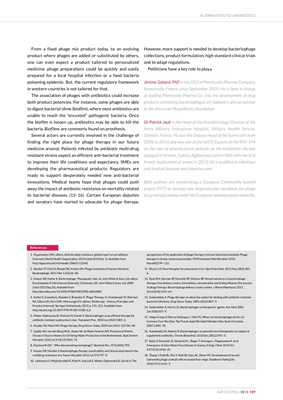
From a fixed phage mix product today, to an evolving
product where phages are added or substituted by others,
one can even expect a product tailored to personalized
medicine: phage preparations could be quickly and easily
prepared for a local hospital infection or a food bacteria
poisoning epidemic. But, the current regulatory framework
in western countries is not tailored for that.
The association of phages with antibiotics could increase
both product potencies. For instance, some phages are able
to digest bacterial slime (biofilm), where most antibiotics are
unable to reach the "encysted" pathogenic bacteria. Once
the biofilm is loosen up, antibiotics may be able to kill the
bacteria. Biofilms are commonly found on prosthesis.
Several actors are currently involved in the challenge of
finding the right place for phage therapy in our future
medicine arsenal. Patients infected by antibiotic multi-drug
resistant strains expect an efficient anti-bacterial treatment
to improve their life conditions and expectancy. SMEs are
developing the pharmaceutical products. Regulators are
ready to support desperately needed new anti-bacterial
innovations. Medical teams hope that phages could push
away the impact of antibiotic resistance on mortality related
to bacterial diseases (13-16). Certain European deputies
and senators have started to advocate for phage therapy.
However, more support is needed to develop bacteriophage
collections, product formulation, high standard clinical trials
and to adapt regulations.
Politicians have a key role to play.l
Jérôme Gabard, PhD is the CEO of Pherecydes Pharma Company,
Romainville, France, since September 2009. He is been in charge
of leading Pherecydes Pharma Co. into the development of drug
products containing bacteriophages. Dr Gabard is also an advisor
to the American PhageBiotics foundation
Dr Patrick Jault is the Head of the Anesthesiology Division of the
Percy Military Instruction Hospital, Military Health Service,
Clamart, France. He was the Deputy-Head of the burns unit from
2008 to 2014 and was one of the NATO Experts of the RTG-194
on the care of severely burnt patients on the battlefield. He was
engaged in Kosovo, Gabon, Afghanistan and in Mali with the first
French deployment of troops in 2013. He is qualified in infectious
and tropical diseases and intensive care.
Both authors are coordinating a European Community funded
project (FP7) to develop new bioproduction standards for phage
drug manufacturing under the European pharmacopeia umbrella.
ALTERNATIVES TO ANTIBIOTICS
AMR CONTROL 2015 109
References
1. Organization WH, others. Antimicrobial resistance: global report on surveillance
[Internet]. World Health Organization; 2014 [cited 2014 Dec 1]. Available from:
http://apps.who.int/iris/handle/10665/112642
2. Abedon ST, Kuhl SJ, Blasdel BG, Kutter EM. Phage treatment of human infections.
Bacteriophage. 2011 Mar 1;1(2):66-85.
3. Harper DR, Kutter E. Bacteriophage: Therapeutic Uses. In: John Wiley & Sons, Ltd, editor.
Encyclopedia of Life Sciences [Internet]. Chichester, UK: John Wiley & Sons, Ltd; 2008
[cited 2013 Sep 26]. Available from:
http://doi.wiley.com/10.1002/9780470015902.a0020000
4. Kutter E, Gvasalia G, Alavidze Z, Brewster E. Phage Therapy. In: Grassberger M, Sherman
RA, Gileva OS, Kim CMH, Mumcuoglu KY, editors. Biotherapy - History, Principles and
Practice [Internet]. Springer Netherlands; 2013. p. 191-231. Available from:
http://dx.doi.org/10.1007/978-94-007-6585-6_8
5. Weber-Da̧browska B, Mulczyk M, Górski A. Bacteriophages as an efficient therapy for
antibiotic-resistant septicemia in man. Transplant Proc. 2003 Jun;35(4):1385-6.
6. Housby JN, Mann NH. Phage therapy. Drug Discov Today. 2009 Jun;14(11-12):536-40.
7. Lodder WJ, van den Berg HHJL, Rutjes SA, de Roda Husman AM. Presence of Enteric
Viruses in Source Waters for Drinking Water Production in the Netherlands. Appl Environ
Microbiol. 2010 Jul 9;76(17):5965-71.
8. Duckworth DH. " Who discovered bacteriophage?". Bacteriol Rev. 1976;40(4):793.
9. Harper DR, Morales S. Bacteriophage therapy: practicability and clinical need meet in the
multidrug-resistance era. Future Microbiol. 2012 Jul;7(7):797-9.
10. Letkiewicz S, Międzybrodzki R, Kłak M, Jończyk E, Weber-Dąbrowska B, Górski A. The
perspectives of the application of phage therapy in chronic bacterial prostatitis: Phage
therapy in chronic bacterial prostatitis. FEMS Immunol Med Microbiol. 2010
Nov;60(2):99-112.
11. Ricard J-D. New therapies for pneumonia: Curr Opin Pulm Med. 2012 May;18(3):181-
6.
12. Ryan EM, Gorman SP, Donnelly RF, Gilmore BF. Recent advances in bacteriophage
therapy: how delivery routes, formulation, concentration and timing influence the success
of phage therapy: Bacteriophage delivery routes review. J Pharm Pharmacol. 2011
Oct;63(10):1253-64.
13. Sulakvelidze A. Phage therapy: an attractive option for dealing with antibiotic-resistant
bacterial infections. Drug Discov Today. 2005;10(12):807-9.
14. Sulakvelidze A, Morris JG. Bacteriophages as therapeutic agents. Ann Med. 2001
Jan;33(8):507-9.
15. Veiga-Crespo P, Barros-Velázquez J, Villa TG. What can bacteriophages do for us?
Commun Curr Res Educ Top Trends Appl Microbiol Mendez-Vilas-Spain Formatex.
2007;2:885-93.
16. Kutateladze M, Adamia R. Bacteriophages as potential new therapeutics to replace or
supplement antibiotics. Trends Biotechnol. 2010 Dec;28(12):591-5.
17. Baize S, Pannetier D, Oestereich L, Rieger T, Koivogui L, Magassouba N, et al.
Emergence of Zaire Ebola Virus Disease in Guinea. N Engl J Med. 2014 Oct
9;371(15):1418-25.
18. Zhang J, Kraft BL, Pan Y, Wall SK, Saez AC, Ebner PD. Development of an antiSalmonella
phage cocktail with increased host range. Foodborne Pathog Dis.
2010;7(11):1415-9.